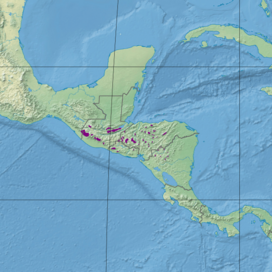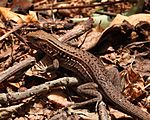Central American montane forests facts for kids
Quick facts for kids Central American montane forests |
|
|---|---|

Central American montane forest,
with Pinus hartwegii, on the slopes of Tajumulco volcano, Guatemala. |
|

Ecoregion territory (in purple)
|
|
| Ecology | |
| Realm | Neotropical |
| Biome | tropical and subtropical moist broadleaf forests |
| Borders | Central American pine–oak forests and Central American Atlantic moist forests |
| Geography | |
| Area | 13,200 km2 (5,100 sq mi) |
| Countries | |
| Conservation | |
| Conservation status | Vulnerable |
| Protected | 31.34% |
The Central American montane forests are special kinds of forests found high up in the mountains of Central America. They are part of a larger group called tropical and subtropical moist broadleaf forests, which means they are warm and wet. These forests are home to many unique plants and animals. The World Wildlife Fund (WWF) has defined them as an important ecoregion.
Contents
Where Are These Forests Found?
These amazing forests are located on the tops and sides of the highest mountains in Central America. You can find them at altitudes from about 1,800 to 4,000 meters (5,900 to 13,000 feet) above sea level. They stretch from the state of Chiapas in southeastern Mexico, through Guatemala, El Salvador, and Honduras, all the way to northern Nicaragua.
The forests cover an area of about 13,200 square kilometers (5,100 square miles). At lower elevations, these montane forests are usually surrounded by Central American pine–oak forests. However, in some areas like northern Guatemala, northern Honduras, and central Nicaragua, they are next to the Central American Atlantic moist forests.
What's the Weather Like?
The climate in these montane forests is humid and cool, especially because they are high up in the mountains. It rains a lot here, with about 2,000 to 4,000 millimeters (79 to 157 inches) of rain each year. Many areas are often covered in thick clouds, making them feel misty.
At the very highest parts of these mountains, it can get quite cold. You might even see frost at night between December and March.
Plants of the Montane Forests
The plants in these forests change depending on how high up you go. You can find different types of plant communities, like wet forests, moist forests, and even subalpine grasslands.
Subalpine Grasslands
The subalpine grasslands are found above 3,050 meters (10,000 feet) on the tall volcanoes. These include Volcán Tacaná and Volcán Tajumulco near the border of Guatemala and Mexico. Here, the trees stop growing around 4,000 meters (13,000 feet) elevation.
In these grasslands, you'll mostly see plants like Lupinus montanus and tall grasses called Calamagrostis vulcanica. There are also many other grasses and small flowering plants, along with lots of mosses covering the ground and rocks.
Animals of the Montane Forests
These unique forests are home to some special animals.
Birds
One interesting bird that lives only in these forests is the horned guan (Oreophasis derbianus). It's a large, turkey-like bird with a distinctive red "horn" on its head.
Mammals
You can also find the narrow-nosed harvest mouse (Reithrodontomys tenuirostris) here. This tiny mouse is endemic, meaning it lives only in the subalpine grasslands of this region.
-
Holcosus undulatus in Antigua Guatemala, Guatemala
Protecting These Forests
It's very important to protect these special montane forests. About 31.34% of this ecoregion is part of protected areas. These areas help keep the plants and animals safe from harm.
Some of the protected areas include:
- La Tigra National Park
- Cerro Saslaya National Park
- Lago de Yojoa Multiple Use Area
- Montecristo National Park
- Macizos de Peñas Blancas Natural Reserve
- Cordillera Dipilto and Jalapa Natural Reserve
- Cerro Kilambe Natural Reserve
- Cerro Tisey–Estanzuela Nature Reserve
- Montecristo Trifinio National Park
- Celaque National Park
These parks and reserves help make sure that these beautiful and important forests will be around for a long time.
See also
 In Spanish: Bosques montanos de América Central para niños
In Spanish: Bosques montanos de América Central para niños


